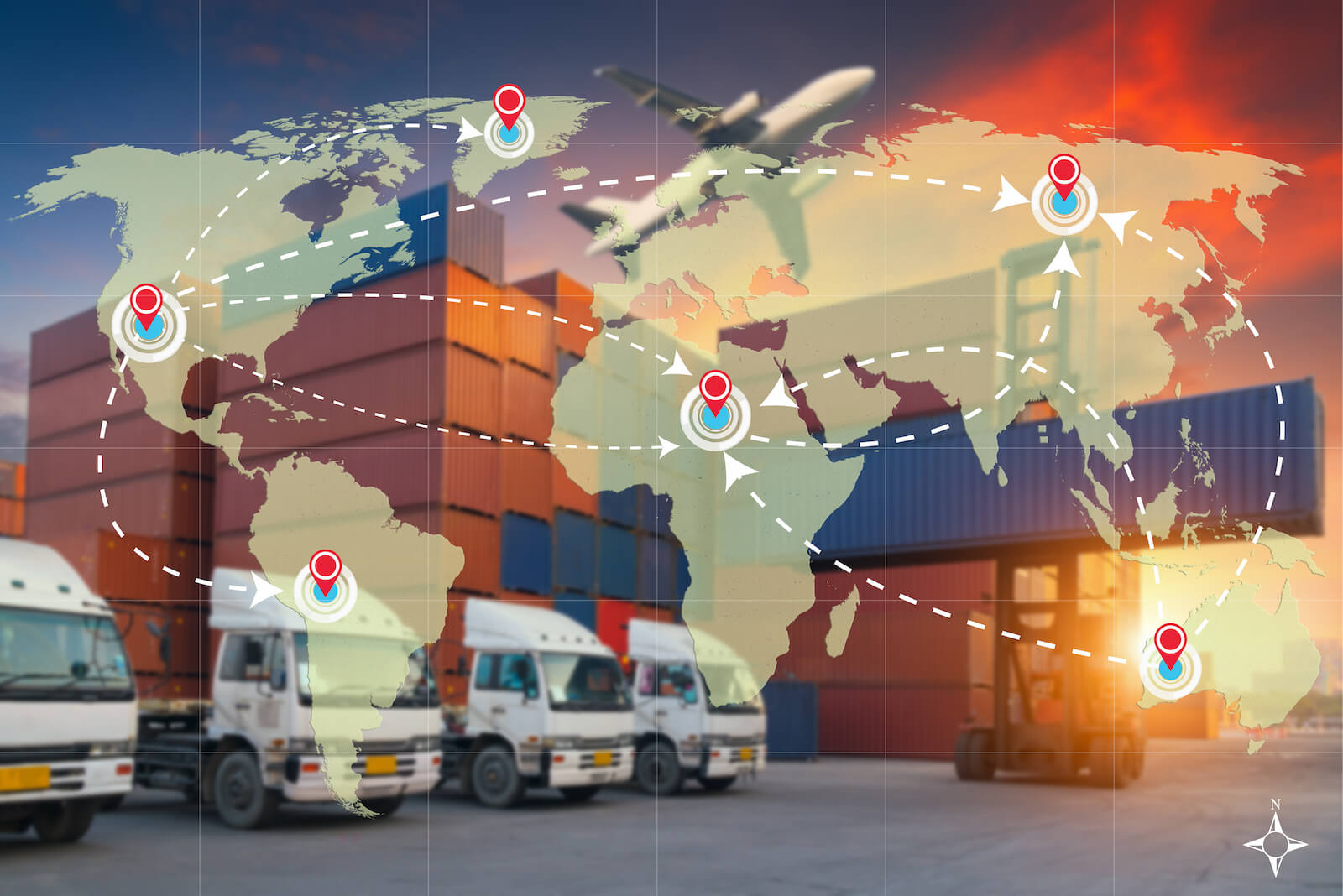Table of Contents
** Minutes
What is the ecommerce supply chain?
What is ecommerce supply chain management?
4 benefits of a streamlined ecommerce supply chain
4 ecommerce supply chain strategies for small or large shops
How ShipBob maximized ecommerce supply chain management for TB12
Picture this: Finished goods are delivered on time, inventory levels are optimized, stockouts are rare, and customer orders are picked, packed, and shipped quickly. Sounds wonderful, right? While this may not be your situation currently, it’s not far out of reach if you take the time to improve your ecommerce supply chain.
Building a strategic ecommerce supply chain is not an easy task as it comes with many moving parts: the transfer of finished goods from the manufacturer to the seller or to a third party, keeping track of inventory levels, managing a warehouse, picking and packing orders, shipping products to customers, and handling returns and reverse logistics. If one stage of the supply chain gets off track, it can derail the entire process’ velocity and cause major delays downstream.
How well your ecommerce business manages its supply chain is a determining factor of future growth. Once you have a solid ecommerce logistics strategy in place, there are always ways to improve your supply chain as you grow your online sales and evolve your business model. The goal is to have your ecommerce supply chain be in sync with your sales channels.
In this article, you will learn how to streamline your ecommerce supply chain, so you can optimize operations at every stage, reduce logistics costs, and keep your team happy and your customers satisfied.
What is the ecommerce supply chain?
The ecommerce supply chain is a sequence of logistics processes, which include the production of raw materials, manufacturing of finished goods, warehousing, inventory management, order fulfillment, and last-mile delivery. The end goal is to deliver a quality product to your customers and a great experience, and every stage of the supply chain plays a key role in running a trustworthy brand.
What is ecommerce supply chain management?
Ecommerce supply chain management oversees the inbound and outbound logistics of finished goods inventory, starting at production all the way to shipping customer orders. A highly optimized supply chain helps to reduce costs and increase productivity, which can impact both profit margins and customer satisfaction.
4 benefits of a streamlined ecommerce supply chain
Finding ways to streamline the supply chain not only improves internal operations, but it can also have a major impact on the customer experience as well. Here are four benefits to streamlining your ecommerce supply chain.
1. Faster shipping times
Any delays in the supply chain should be identified and improved upon, especially when it comes to shipping. Two major factors that impact shipping times include:
- Where your manufacturers, warehouses, and end customers are located
- Mode of transportation (e.g., air, ocean, or freight)
Shipping is one of the most important stages in the supply chain to get right. It can help to reduce cart abandonment, give you a competitive advantage, and even match a similar service to Amazon.
2. Cost-effective shipping rates
To optimize an ecommerce supply chain, you will want to find ways to reduce shipping costs over time. Some examples include using the right packaging for products based on weight and dimensions, splitting inventory across geographic locations once it’s cost-effective, and looking into shipping discounts from carriers based on order volume.
Choosing the right mode of transportation can make a major impact on shipping rates. Expedited shipping via air might be fast, but it can also be costly. On the other hand, freight shipping comes with more cost-effective transportation methods. For instance, LTL freight (less-than-truckload) allows shippers to consolidate their cargo with the cargo of other shippers heading in the same direction. That way, you only pay for your portion of the trailer rather than in full.
3. Accurate inventory management
Inventory management plays a key role in the ecommerce supply chain. By optimizing inventory levels, you can:
- Optimize stock control
- Avoid unnecessary stockouts and dead stock
- Forecast future demand
- Simplify inventory valuation
There are several ways to tackle common ecommerce inventory challenges, such as setting reorder points based on historical order data and future projections, regularly auditing inventory, and implementing inventory management software.
4. Better customer experiences
A streamlined ecommerce supply chain ensures that you can deliver the best customer experience for every order. By finding ways to improve the supply chain, you can charge less for shipping, speed up delivery times, and reduce the risk of human error due to a poorly run chain.
As your ecommerce supply chain gets stronger, you can focus more energy on improving customer communication by enabling customers to track orders in real-time and providing customers with updates, from when an order is processed to when it’s delivered.
4 ecommerce supply chain strategies for small or large shops
Supply chain managers should always be looking for ways to improve and optimize logistics systems and fulfillment. Here are some tried-and-tested strategies that fast-growing direct-to-consumer (DTC) brands and small businesses have done to increase efficiency and improve online sales, whether on a single store or taking an omnichannel approach.
1. Use multiple fulfillment centers
It’s no surprise that customers expect fast delivery times at an affordable price (often free). By using multiple warehousing and storage locations, you can expand customer reach and significantly reduce delivery times.
For instance, fulfillment provider ShipBob offers a growing network of fulfillment centers across the United States, and in Canada and Europe. Powered by proprietary technology, ShipBob merchants can choose to store inventory in one or more ShipBob locations to reduce fulfillment costs and transit times, while tracking inventory and order data all from one dashboard.
“We love that ShipBob actually operates its fulfillment centers — they know their operations and they are very clear about it. ShipBob having multiple locations was also huge for us. Keeping our inventory in Chicago and Los Angeles has brought cost savings since we ship from the locations that are closest to the customer.”
Courtney Lee, founder of Prymal
2. Implement real-time inventory management
As orders are placed and shipped out, inventory control is a challenge if not managed quickly and in real-time. The right inventory management system or an ERP inventory system can help you prevent stockouts, optimize freight shipping from your manufacturer, and speed up customer deliveries. You can also access a wealth of data and analytics to help you make better decisions on how to improve your supply chain.
“ShipBob’s analytics tool is really cool. It helps us a lot with planning inventory reorders, seeing when SKUs are going to run out, and we can even set up email notifications so that we’re alerted when a SKU has less than a certain quantity left. There is a lot of value in their technology.”
Oded Harth, CEO & Co-Founder of MDacne
3. Optimize your warehouse
From managing your warehouse staff to monitoring the movement of inventory, you will want to keep a close eye on how you can improve inventory storage, reduce carrying costs, and find ways to streamline the fulfillment process.
A warehouse management system can help to manage inventory levels and storage, improve productivity, and efficiently fulfill orders. It can also help to take the guesswork out of the process, save time, and reduce human error, without the need to continuously conduct warehouse audits.
“Our old 3PL had 1,500 units of missing inventory that they couldn’t find. Because of a lack of ownership of the entire fulfillment stack, it’s been difficult to rectify, unlike with ShipBob who owns the entire stack: inventory and order management system, warehouse management system, and their fulfillment centers.”
Gerard Ecker, Founder & CEO of Ocean & Co.
4. Partner with a 3PL
Managing a fast-moving ecommerce supply chain with many moving parts can be a challenge. Many fast-growing ecommerce brands choose to partner with a logistics company that offers a network of fulfillment locations, connected technology, and deep ecommerce supply chain expertise.
A best-in-class third-party logistics (3PL) company like ShipBob can help you with supply chain planning in a number of ways. By simply outsourcing fulfillment to ShipBob, you’re given solutions to many common ecommerce supply chain challenges.
With ShipBob, you can store inventory in one or more strategic fulfillment center locations (with international fulfillment capabilities), gain full visibility into inventory and order management, and get real-time insights into shipping costs, fulfillment performance, demand forecasting, and more.
“ShipBob has been with us since day one of shipping our Kickstarter backer rewards and has since fulfilled nearly a quarter of a million orders for us. ShipBob’s customer service continues to improve with direct contacts that know our account, real-time follow through, and a better customer delivery experience. They are a fulfillment partner that is truly an extension of our brand.”
Manuel de la Cruz, CEO at Boie
How ShipBob maximized ecommerce supply chain management for TB12
TB12 is Tom Brady’s health and wellness brand that provides buyers with apparel, protein powders, exercise equipment, fitness products, and more. TB12 initially relied on a Massachusetts-based 3PL provider to optimize its ecommerce supply chain and fulfill orders. However, as the brand grew, they knew they needed a more reliable and scalable 3PL that can help reduce fulfillment costs and offer faster shipping.
Impressed by ShipBob’s commitment to improvement and its industry-leading software, TB12 chose ShipBob to be their new 3PL. Since partnering with ShipBob several years ago, TB12 has experienced a 25% reduction in fulfillment costs.
“Customers get accustomed to a certain service level at a low price — often free — and want it faster over time. Ever since we started our partnership with ShipBob in the summer of 2018, they’ve been able to deliver the customer service level we need at the right cost.”
Michael Peters, VP of E-Commerce Operations at TB12
Conclusion
By finding ways to optimize your ecommerce supply chain, you can build a more efficient team by eliminating headaches and improving productivity. With a streamlined supply chain, you will ultimately deliver a better customer experience by avoiding stockouts, offering better shipping rates, and speeding up delivery times.
ShipBob’s team can help you optimize fulfillment logistics with an international fulfillment network, proprietary technology, and a team of experts who can help your business grow. To learn more about how ShipBob works, click the button below.
Ecommerce supply chain FAQs
An efficient supply chain is key to running a successful ecommerce brand. Here are some of the most frequently asked questions about how to streamline the ecommerce supply chain.
What is the ecommerce supply chain?
The ecommerce supply chain is a sequence of processes, which include the production of raw materials, manufacturing of finished goods, warehouse management, inventory storage, order fulfillment, and shipping. Every stage in the ecommerce supply chain plays a key role in getting orders to the customer’s door in a timely manner.
How do I optimize my ecommerce supply chain?
There are several ways to optimize your ecommerce supply chain. One way is to consider storing inventory in multiple strategic locations that are close to your customers. That way, you can reduce shipping costs by reducing your orders’ average shipping zones. Other common ways to optimize your supply chain is to implement automation, use inventory management tools, and monitor supplier performance.
How does the ecommerce supply chain work?
An ecommerce supply chain is made up of a lot of moving parts, from transporting goods from manufacturer to a distribution center, to managing inventory and orders in real-time. Technology and automation play a key role as it helps to improve communication and transfer information between suppliers and buyers, sellers and customers, shipping carriers and sellers, and more.



